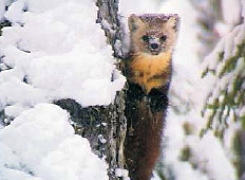
American Marten
Martes americanus atrata
Status
The marten is one of few land mammals native to Newfoundland, and the sub-species is endemic to Canada.
Habitat
Marten appear to prefer habitat with a structure oftern associated with an over-mature forest. There they find older trees with a number of dying or dead trees scatted on the forest floor or leanting on other trees. They appear to prefer thick shady woods with a dense canopy and may avoid large openings or clearings. For denning and nesting sites, marten use hollow trees, stumps, logs and rock crevices.
Range
American marten – Newfoundland population, is found only on the Island of Newfoundland. Most of the population occurs in the area of Little Grand Lake, with other, smaller populations located at Red Indian Lake, Glover Island, Main River, and Terra Nova National Park. Scattered pockets of animals are found in adjacent areas. Historically, marten were found throughout most of the island.
Food
Marten are carnivores, or meat-eaters, whose main food consists of small animals such as meadow voles, shrews, snowshoe hares, red squirrels and birds. They also feed on berries, bird eggs, insects and carrion when available.
Predators/Threats
Major limiting factors are accidental trapping and snaring, and habitat loss due to forestry, fire, and insect damage.
Lifespan
Marten live approximately 8-10 years in the wild
Appearance
The Newfoundland marten is a member of the weasel family. It has a slender body with short limbs, and a long, bushy tail. Its fur is soft, dense, and yellowish-brown, darker on the tail and legs, and lighter on the belly. It has a pale, buff patch on the throat.
Breeding Biology
Marten reach adult size at about three and half months of age. Females are usually over two years old before they have their first litter. Generally, loners, they come together only briefly during the mid-summer breeding season, often mating with several partners. Birth occurs 220-276 days after fertilization. For most of that time, the egg is in in a resting state, known as delayed implantation. The active pregnancy lasts only about one month. Kits are born in March/April; they weigh about one ounce and for the first two to three weeks they are blond, deaf and naked. the mother’s den usually consists of an underground crevice or cavity. Sometimes, marten will take over a squirrel’s nest or even use a woodpecker’s nest in an old snag tree.
Average Weight/Measurements
Males have an average length of 50 to 63 cm (20 to 25 in.) including a 17 cm (7 in.) tail. Their average weight is 1100 g (2.4 lb.). Females average 46 to 56 cm (18 to 22 in.) including a 15 cm (6 in.) tail. The average weight is 750 g (1.6 lb.)
Notes:
At Salmonier Nature Park
- The animal on display at the Park is a captive bred marten, which was part of the park’s captive breeding marten program. It is unreleasable to the wild.
- Marten have been moved from “endangered” status to “threatened” status in 2007 due to an increase in their population.
- The marten is one of only 14 native mammal species on the Island of Newfoundland. It was once trapped for its fur.
